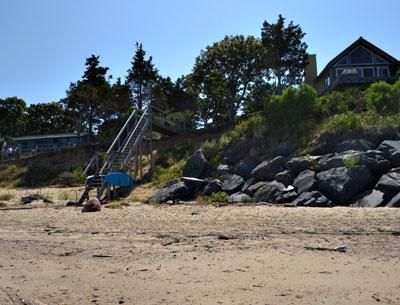Trustees Say No To Revetment

The East Hampton Town Trustees voted unanimously on Tuesday to deny an application for a rock revetment on the beach at Gardiner’s Bay near the end of Louse Point.
The owners of four adjoining properties on Louse Point Road in Springs — the only section of shoreline there that is not protected by so-called “hard” structures — have long sought to construct a revetment that would span 560 feet. One homeowner, John Mullen, has attended several trustees meetings with Charles Voorhis of the environmental planning consultancy Nelson, Pope and Voorhis, to plead his case.
The proposal is also before the town zoning board of appeals, which has held one hearing on it and is awaiting further information.
The trustees, who own and manage most of the town’s beaches and waterways on behalf of the public, are skeptical about hard structures, often insisting that they do more harm than good. Instead, they say, a “soft” solution such as sand, beach grass, and a gentle slope, absorbs a wave’s energy, while a hard structure like a revetment or bulkheadresults in scouring of adjacent shoreline and further loss of beach.
The applicants had been asked to try to come up with a combination of hard and soft structures, one that would protect their houses and at the same time maintain the beach. On Tuesday, however, the trustees found that they had remained firm in their desire for a rock revetment.
Bill Taylor, a trustee and the town’s waterways management supervisor, suggested instead that 10,000 to 15,000 cubic yards of sand from a dredge spoil excavated from Accabonac Harbor in 2012 and 2013 be trucked in and redistributed on the site. “Put enough sand down there in the right volume in that location,” he said. “I think it would be the best place in town to demonstrate that a soft solution could work.”
“But we have proposed that,” said Diane McNally, the trustee clerk, or presiding officer. True, she said, the applicants have lost some land in extreme-weather events in the last few years. “But I know the ‘jurisdiction’ question is going to be thrown right back at us, no matter what, if we decide negatively.” Several oceanfront property owners have challenged the trustees’ jurisdiction in their own efforts to construct revetments on the beach.
“I believe Mr. Mullen is almost 80 feet back. It’s not like he’s hanging off a cliff,” said Brian Byrnes, a trustee.
Ms. McNally acknowledged that some 30 feet of beach has been lost, “through natural and man-made causes,” in recent years. “We go over this and over this and over this,” she said in frustration.
Deborah Klughers, a trustee, cut to the chase. “Can I make a motion to deny all these applications as submitted? I’d like to have made it almost a year ago, but I’ll make it tonight. . . . It’s not the right project for the property.” She complained that the applicants did not take any of the trustees’ suggestions to the Z.B.A. or the state Department of Environmental Conservation, whose permission would also be needed for the revetment’s construction. “They’ve just continued to go forward with what they originally proposed,” she said.
In fairness, Ms. McNally said, Mr. Mullen had expressed interest in the trustees’ alternative proposal, “but his engineer,” Mr. Voorhis, “said no, if you do that you lose the ability to protect against the 100-year storm.”
Aerial photographs, she said, demonstrate that there is more beach at the unprotected shoreline than where the revetments and bulkheads are situated. Mr. Mullen had argued that that was simply because the bluffs have been eroded by storms, giving the appearance of more beach.
Referring to “the fact that they’re before the Z.B.A.,” Mr. Byrnes said he would “vote in favor of denying it.” His colleagues unanimously agreed.
The trustees discussed tempering their denial with continued encouragement of a soft solution. But the applicants, Ms. McNally predicted, “are going to claim we don’t have jurisdiction.”
“We have jurisdiction,” Ms. Klughers said flatly.
